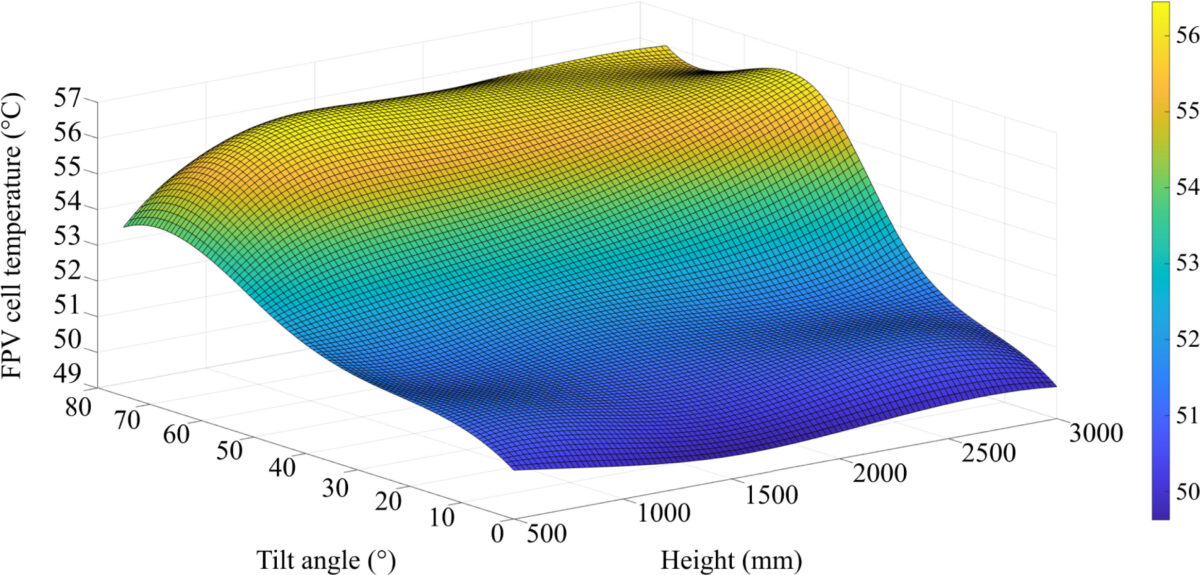A group of researchers from Malaysia and India has analyzed the effect of height, tilt angle, wind velocity, ambient temperature, and water temperature on the efficiency and output of floating solar PV (FPV) compared with a conventional ground-mounted solar system.
The scientists explained that the reference ground-mounted installation “allies” with the nominal operating cell temperature (NOCT PV).
“The study on the impact of height and tilt angle on the temperature drop of photovoltaic panel placed in water is crucial,” they said. “The comparative model NOCT PV serves as the basis for comparison and analysis that resembles the cooling supplied only by wind. Whereas in an FPV the cooling is the combined contribution of wind and water.”
The analysis of the various parameters found the optimum design for FPV to be a 0-degree tilt angle with a height of 1500 mm in order to achieve maximum cooling. With this design, the FPV is 4.33 C cooler than the NOCT PV in comparison. Overall, the researchers concluded that FPVs perform better than NOCT PVs with tilt angles less than 45 degrees, irrespective of height, while NOCT PVs achieve comparatively lower cell temperatures when the title angle is greater than 55 degrees.
The group used a computational fluid dynamic (CFD) simulation for a 2D solar PV module using a finite volume approach. It performed multiple simulations using different parameter combinations. The wind and water temperatures varied between 20 C and 40 C, while the wind velocity was modified from 1 m/s to 5 m/s. The analysis also used six different heights – ranging from 250 mm to 3000 mm – and six different tilt angles between 0 degrees and 75 degrees.
“The following conclusions can be made on the basis of the observations,” the academics explained. “Water needs to be 2 C lower than the air to experience the cooling effect in an FPV system. The temperature of the FPV cell decreases by 1 C when the water temperature is 5 C lower than the ambient temperature. Further, for each 3 C decrease in the water temperature, the temperature of the solar photovoltaic cell decreases by 1 C.”
The researchers observed that a tilt angle greater than 55 degrees provides a significant wind velocity that promotes high heat transfer. They found that the amount of temperature reduction due to wind in an NOCT PV exceeds that for an FPV “for a higher height and tilt angle.”
pv magazine print edition
The findings are available in the report “Design study on the parameters influencing the performance of floating solar PV,” published in Renewable Energy. The group comprised researchers from Curtin University and the Assam Energy Institute.
The report highlights that “the power production and the efficiency of a solar PV decreases by 0.4% to 0.5% for a degree Celsius increase in the temperature.” Therefore, a reduction in cell temperature is important to increase the energy yield of a PV system.
This content is protected by copyright and may not be reused. If you want to cooperate with us and would like to reuse some of our content, please contact: editors@pv-magazine.com.




2 comments
By submitting this form you agree to pv magazine using your data for the purposes of publishing your comment.
Your personal data will only be disclosed or otherwise transmitted to third parties for the purposes of spam filtering or if this is necessary for technical maintenance of the website. Any other transfer to third parties will not take place unless this is justified on the basis of applicable data protection regulations or if pv magazine is legally obliged to do so.
You may revoke this consent at any time with effect for the future, in which case your personal data will be deleted immediately. Otherwise, your data will be deleted if pv magazine has processed your request or the purpose of data storage is fulfilled.
Further information on data privacy can be found in our Data Protection Policy.